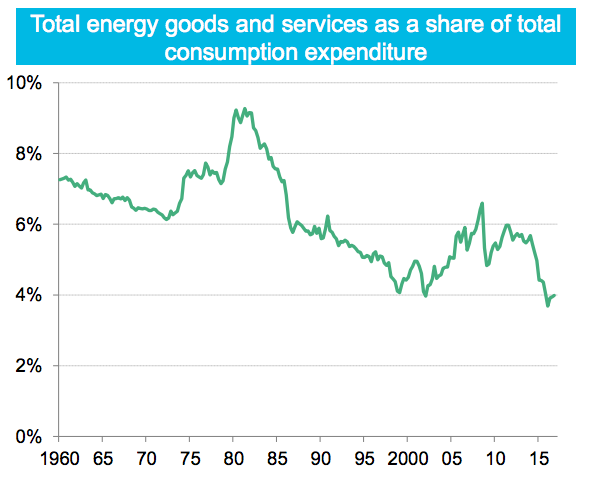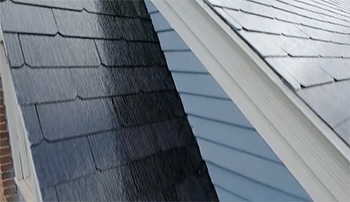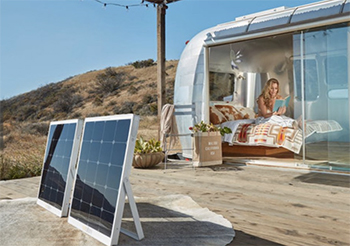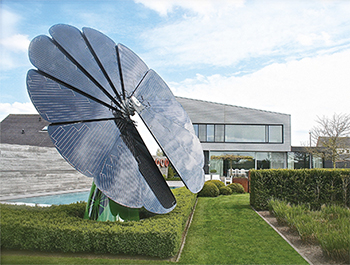Here’s a fact that may surprise you. The average U.S. household today spends a smaller percentage of their total income on energy costs than they did in 1960.
According to the 2017 Sustainable Energy in America Factbook, published by The Business Council for Sustainability, in partnership with Bloomberg New Energy Finance, Americans are dedicating less of their household spending to energy than at any other time since tracking began in 1959.
So, despite the fact that the average household today has 2.93 TV sets and 10 to 12 devices capable of connecting to the internet (not to mention 5x more appliances and gadgets), energy consumption costs as a share of total expenditures averaged 3.9% in 2016 versus 7.3% in 1960.

From 2017 Sustainable Energy in America Factbook
It may seem hard to believe given that we charge everything from our phones, to our laptops, to our tablets and even our watches on a nightly basis — something no one in 1960 would have fathomed. And think about all the gadgets we now use daily without much thought — like that Ninja coffee maker, the Cuisinart or a fridge that provides you recipes based on the contents inside (on the menu tonight was wine with a side of eggs and alfalfa sprouts – confirmation that I really need to go grocery shopping).
A substantial part of the reduction in consumption costs is due to advances in energy efficiency. New homes built in 2000 and later are about 30% larger than older homes, but consume only 2% more energy. Today’s home consumes about 21% less energy for heating and cooling than it did just 20 years ago. Programmable thermostats are present in more than 37% of all households. Smart thermostats, that use wireless communications to control appliances and other smart devices within homes, are gaining traction and they may even serve as the control platform for “smart homes.”
Think of the massive changes we’ve seen in light bulbs the last few years as governments around the world passed measures to phase out incandescent light bulbs in favor of more energy-efficient alternatives. Even our refrigerators today use about 51% less electricity than they did in 1960. So while we use more devices today than we have in the past, those devices are much more efficient.
Beyond advances in energy efficiency, consumers are also getting smarter and more educated about their energy usage. They are actively seeking ways to reduce their footprint and save money. And succeeding. Currently, the residential sector accounts for about 38 percent of total U.S. electricity demand. While the number of U.S. households has been increasing, and is expected to continue, estimated electricity usage per household in 2040 is projected to be 10 percent lower than 2013 levels according to projections at Energy.gov.
Another big part of the story is the increase in renewal energy generation. Together, natural gas and renewable energy generated nearly 50% of U.S. electricity in 2016. While renewable generation has typically been more costly, costs are decreasing as it scales. We’ve all seen the growth in the big wind farms (and the growing number of trucks moving those big wind turbine parts), however renewal energy technology is rapidly developing at a smaller scale for home use as well. And will become more and more affordable as it matures.
 Tesla recently announced that they will begin selling a solar roof shingle later this year. They plan to offer four types of shingles to match different housing aesthetics and you’d be hard pressed to even know from looking that it’s a solar roof. That’s really the whole crux of Tesla’s solar roof vision: to create something that’s both aesthetically appealing and efficient. Tesla CEO Elon Musk has said it looks “quite promising” that the solar roof could be cheaper than a normal roof, factoring in the price of labor.
Tesla recently announced that they will begin selling a solar roof shingle later this year. They plan to offer four types of shingles to match different housing aesthetics and you’d be hard pressed to even know from looking that it’s a solar roof. That’s really the whole crux of Tesla’s solar roof vision: to create something that’s both aesthetically appealing and efficient. Tesla CEO Elon Musk has said it looks “quite promising” that the solar roof could be cheaper than a normal roof, factoring in the price of labor.
 Other new consumer products hitting the market include Solpad, an all-in-one mobile solar generator that is a turnkey solution you can use at home or take anywhere. Just point it at the sun and it collects and stores usable energy capable of recharging your smartphone up to 60 times, a tablet as many as 30 times, and most laptops four to seven times. On top of that, the device can even provide enough power to run a mini-fridge for up to 10 hours or a flat-panel TV for four hours. You can hook several panels together if you need to generate more power.
Other new consumer products hitting the market include Solpad, an all-in-one mobile solar generator that is a turnkey solution you can use at home or take anywhere. Just point it at the sun and it collects and stores usable energy capable of recharging your smartphone up to 60 times, a tablet as many as 30 times, and most laptops four to seven times. On top of that, the device can even provide enough power to run a mini-fridge for up to 10 hours or a flat-panel TV for four hours. You can hook several panels together if you need to generate more power.
 Smartflower Solar, which has been all over Facebook the last few months, showcases the design of a fully integrated, all-in-one solar system that is 40% more efficient than traditional solar and can live anywhere (and move with you). The Smartflower consists of panels which fan out each morning to create a flower-like array and then positions itself to face the sun so it can immediately begin generating energy. Throughout the day, the smart solar power system tracks the sun’s position on a dual axis so that the solar panels are always at an optimum angle for capturing solar energy.
Smartflower Solar, which has been all over Facebook the last few months, showcases the design of a fully integrated, all-in-one solar system that is 40% more efficient than traditional solar and can live anywhere (and move with you). The Smartflower consists of panels which fan out each morning to create a flower-like array and then positions itself to face the sun so it can immediately begin generating energy. Throughout the day, the smart solar power system tracks the sun’s position on a dual axis so that the solar panels are always at an optimum angle for capturing solar energy.
Few would argue that our lifestyles today are dependent upon energy. And demand will only continue to grow. So to keep costs under control and wisely use resources, we can expect ongoing and fundamental transformation in how energy is used and produced. This will mean new science, technology and public policy innovations aimed at being efficient in our use of energy, reducing our environmental impact and enhancing our energy security.



